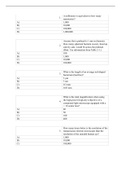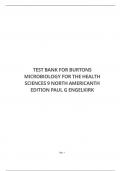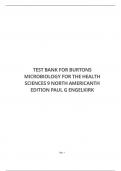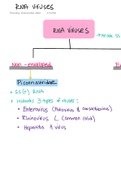All 10 results
Sort by
Best selling Burton\'s Microbiology for the Health Sciences notes

-
Test Bank for Burton's Microbiology for the Health Sciences – 9th edition by Paul G. Engelkirk
- Exam (elaborations) • 9 pages • 2022 Popular
-
- $17.49
- 1x sold
- + learn more
Test Bank for Burton's Microbiology for the Health Sciences – 9th edition by Paul G. EngelkirkTest Bank for Burton's Microbiology for the Health Sciences – 9th edition by Paul G. EngelkirkTest Bank for Burton's Microbiology for the Health Sciences – 9th edition by Paul G. EngelkirkTest Bank for Burton's Microbiology for the Health Sciences – 9th edition by Paul G. EngelkirkTest Bank for Burton's Microbiology for the Health Sciences – 9th edition by Paul G. EngelkirkTest ...

-
Chapter 4 - Acellular and Prokaryotic Microbes
- Class notes • 35 pages • 2021 Popular
-
- $2.99
- + learn more
Imagine the excitement that Anton van Leeuwenhoek experienced as he gazed through his tiny glass lenses and became the first person to see live microbes. In the years that have followed his eloquently written late 17th-century to early 18th-century accounts of the bacteria and protozoa that he observed, tens of thousands of microbes have been discovered, described, and classified. In this chapter and the next, you will be introduced to the diversity of form and function that exists in the microb...

-
Chapter 4 - Acellular and Prokaryotic Microbes
- Class notes • 35 pages • 2021 Popular
-
- $2.99
- + learn more
Imagine the excitement that Anton van Leeuwenhoek experienced as he gazed through his tiny glass lenses and became the first person to see live microbes. In the years that have followed his eloquently written late 17th-century to early 18th-century accounts of the bacteria and protozoa that he observed, tens of thousands of microbes have been discovered, described, and classified. In this chapter and the next, you will be introduced to the diversity of form and function that exists in the microb...
Do you also write study notes yourself? Put them up for sale and earn every time your document is purchased.

-
DNA viruses
- Class notes • 1 pages • 2022 Popular
-
- $8.49
- + learn more
The document includes examples and an explanation for both enveloped and non-enveloped DNA viruses. It also provides you with different functions and the viruses associated with these functions. The document also includes the result of converting ds dna and ss dna.

-
TEST BANK FOR BURTONS MICROBIOLOGY FOR THE HEALTH SCIENCES 9 NORTH AMERICANTH EDITION PAUL G ENGELKIRK
- Exam (elaborations) • 7 pages • 2023 Popular
-
- $10.00
- + learn more
1. Which of the following individuals is considered to be the “Father of Microbiology” ? A) Anton van Leeuwenhoek B) Louis Pasteur C) Robert Koch D) Rudolf Virchow 2. The microorganisms that usually live on or within a person are collectively referred to as A) germs. B) indigenous microflora. C) nonpathogens. D) opportunistic pathogens. 3. Microorganisms that live on dead and decaying organic material are known as A) indigenous microflora. B) parasites. C) pathogens. D) saprop...

-
TEST BANK FOR BURTONS MICROBIOLOGY FOR THE HEALTH SCIENCES 9 NORTH AMERICANTH EDITION PAUL G ENGELKIRK
- Exam (elaborations) • 7 pages • 2023 Popular
-
- $10.00
- + learn more
1. Which of the following individuals is considered to be the “Father of Microbiology” ? A) Anton van Leeuwenhoek B) Louis Pasteur C) Robert Koch D) Rudolf Virchow 2. The microorganisms that usually live on or within a person are collectively referred to as A) germs. B) indigenous microflora. C) nonpathogens. D) opportunistic pathogens. 3. Microorganisms that live on dead and decaying organic material are known as A) indigenous microflora. B) parasites. C) pathogens. D) saprop...

-
Viewing the Microbial World
- Class notes • 32 pages • 2021 Popular
-
- $2.99
- + learn more
Microbes are very tiny. But how tiny are they? In most cases, some type of microscope is required to see them; thus, microbes are said to be microscopic. Various types of microscopes are discussed in this chapter. The metric system will be discussed first, however, because metric system units of length are used to express the sizes of microbes and the resolving power of optical instruments

-
Chapter 4 - Acellular and Prokaryotic Microbes
- Class notes • 35 pages • 2021 Popular
-
- $2.99
- + learn more
Imagine the excitement that Anton van Leeuwenhoek experienced as he gazed through his tiny glass lenses and became the first person to see live microbes. In the years that have followed his eloquently written late 17th-century to early 18th-century accounts of the bacteria and protozoa that he observed, tens of thousands of microbes have been discovered, described, and classified. In this chapter and the next, you will be introduced to the diversity of form and function that exists in the microb...

-
RNA viruses
- Summary • 1 pages • 2022 Popular
-
- $10.19
- + learn more
The document includes everything you need to know for your exam about RNA viruses. Examples are included with explanations. They are written in a way that will help you understand and differentiate between DNA and RNA viruses, and different examples of different types of RNA viruses. The document also includes a simplified explanation of how the replication and multiplication process happens in RNA viruses. The examples are written in a way that will help you organize the information and memoriz...

-
Microbiology - The Science
- Class notes • 27 pages • 2021 Popular
-
- $2.99
- + learn more
Welcome to the fascinating world of microbiology, where you will learn about creatures so small that the vast majority cannot be seen with the naked eye. In this chapter, you will discover the effects that these tiny creatures have on our daily lives, the ecosystems, and the environment around us, and why knowledge of them is of great importance to healthcare professionals. You will learn that some of them are our friends, whereas others are our enemies.
Newest Burton\'s Microbiology for the Health Sciences summaries

-
TEST BANK FOR BURTONS MICROBIOLOGY FOR THE HEALTH SCIENCES 9 NORTH AMERICANTH EDITION PAUL G ENGELKIRK
- Exam (elaborations) • 7 pages • 2023 New
-
- $10.00
- + learn more
1. Which of the following individuals is considered to be the “Father of Microbiology” ? A) Anton van Leeuwenhoek B) Louis Pasteur C) Robert Koch D) Rudolf Virchow 2. The microorganisms that usually live on or within a person are collectively referred to as A) germs. B) indigenous microflora. C) nonpathogens. D) opportunistic pathogens. 3. Microorganisms that live on dead and decaying organic material are known as A) indigenous microflora. B) parasites. C) pathogens. D) saprop...

-
TEST BANK FOR BURTONS MICROBIOLOGY FOR THE HEALTH SCIENCES 9 NORTH AMERICANTH EDITION PAUL G ENGELKIRK
- Exam (elaborations) • 7 pages • 2023 New
-
- $10.00
- + learn more
1. Which of the following individuals is considered to be the “Father of Microbiology” ? A) Anton van Leeuwenhoek B) Louis Pasteur C) Robert Koch D) Rudolf Virchow 2. The microorganisms that usually live on or within a person are collectively referred to as A) germs. B) indigenous microflora. C) nonpathogens. D) opportunistic pathogens. 3. Microorganisms that live on dead and decaying organic material are known as A) indigenous microflora. B) parasites. C) pathogens. D) saprop...

-
Test Bank for Burton's Microbiology for the Health Sciences – 9th edition by Paul G. Engelkirk
- Exam (elaborations) • 9 pages • 2022 New
-
- $17.49
- 1x sold
- + learn more
Test Bank for Burton's Microbiology for the Health Sciences – 9th edition by Paul G. EngelkirkTest Bank for Burton's Microbiology for the Health Sciences – 9th edition by Paul G. EngelkirkTest Bank for Burton's Microbiology for the Health Sciences – 9th edition by Paul G. EngelkirkTest Bank for Burton's Microbiology for the Health Sciences – 9th edition by Paul G. EngelkirkTest Bank for Burton's Microbiology for the Health Sciences – 9th edition by Paul G. EngelkirkTest ...
Do you also write study notes yourself? Put them up for sale and earn every time your document is purchased.

-
DNA viruses
- Class notes • 1 pages • 2022 New
-
- $8.49
- + learn more
The document includes examples and an explanation for both enveloped and non-enveloped DNA viruses. It also provides you with different functions and the viruses associated with these functions. The document also includes the result of converting ds dna and ss dna.

-
RNA viruses
- Summary • 1 pages • 2022 New
-
- $10.19
- + learn more
The document includes everything you need to know for your exam about RNA viruses. Examples are included with explanations. They are written in a way that will help you understand and differentiate between DNA and RNA viruses, and different examples of different types of RNA viruses. The document also includes a simplified explanation of how the replication and multiplication process happens in RNA viruses. The examples are written in a way that will help you organize the information and memoriz...

-
Chapter 4 - Acellular and Prokaryotic Microbes
- Class notes • 35 pages • 2021 New
-
- $2.99
- + learn more
Imagine the excitement that Anton van Leeuwenhoek experienced as he gazed through his tiny glass lenses and became the first person to see live microbes. In the years that have followed his eloquently written late 17th-century to early 18th-century accounts of the bacteria and protozoa that he observed, tens of thousands of microbes have been discovered, described, and classified. In this chapter and the next, you will be introduced to the diversity of form and function that exists in the microb...

-
Chapter 4 - Acellular and Prokaryotic Microbes
- Class notes • 35 pages • 2021 New
-
- $2.99
- + learn more
Imagine the excitement that Anton van Leeuwenhoek experienced as he gazed through his tiny glass lenses and became the first person to see live microbes. In the years that have followed his eloquently written late 17th-century to early 18th-century accounts of the bacteria and protozoa that he observed, tens of thousands of microbes have been discovered, described, and classified. In this chapter and the next, you will be introduced to the diversity of form and function that exists in the microb...

-
Chapter 4 - Acellular and Prokaryotic Microbes
- Class notes • 35 pages • 2021 New
-
- $2.99
- + learn more
Imagine the excitement that Anton van Leeuwenhoek experienced as he gazed through his tiny glass lenses and became the first person to see live microbes. In the years that have followed his eloquently written late 17th-century to early 18th-century accounts of the bacteria and protozoa that he observed, tens of thousands of microbes have been discovered, described, and classified. In this chapter and the next, you will be introduced to the diversity of form and function that exists in the microb...

-
Microbiology - The Science
- Class notes • 27 pages • 2021 New
-
- $2.99
- + learn more
Welcome to the fascinating world of microbiology, where you will learn about creatures so small that the vast majority cannot be seen with the naked eye. In this chapter, you will discover the effects that these tiny creatures have on our daily lives, the ecosystems, and the environment around us, and why knowledge of them is of great importance to healthcare professionals. You will learn that some of them are our friends, whereas others are our enemies.

-
Viewing the Microbial World
- Class notes • 32 pages • 2021 New
-
- $2.99
- + learn more
Microbes are very tiny. But how tiny are they? In most cases, some type of microscope is required to see them; thus, microbes are said to be microscopic. Various types of microscopes are discussed in this chapter. The metric system will be discussed first, however, because metric system units of length are used to express the sizes of microbes and the resolving power of optical instruments

Did you know that on average a seller on Stuvia earns $82 per month selling study resources? Hmm, hint, hint. Discover all about earning on Stuvia
